Medical Research Proposal Samples
-
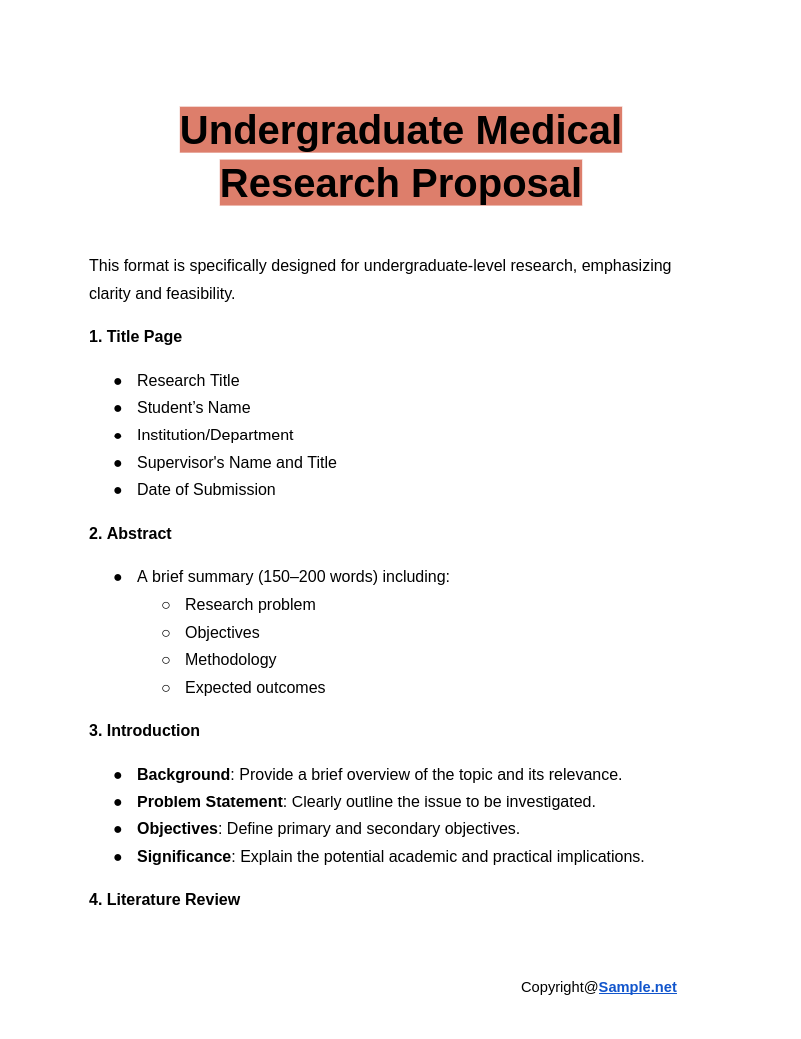
Undergraduate Medical Research Proposal
download now -
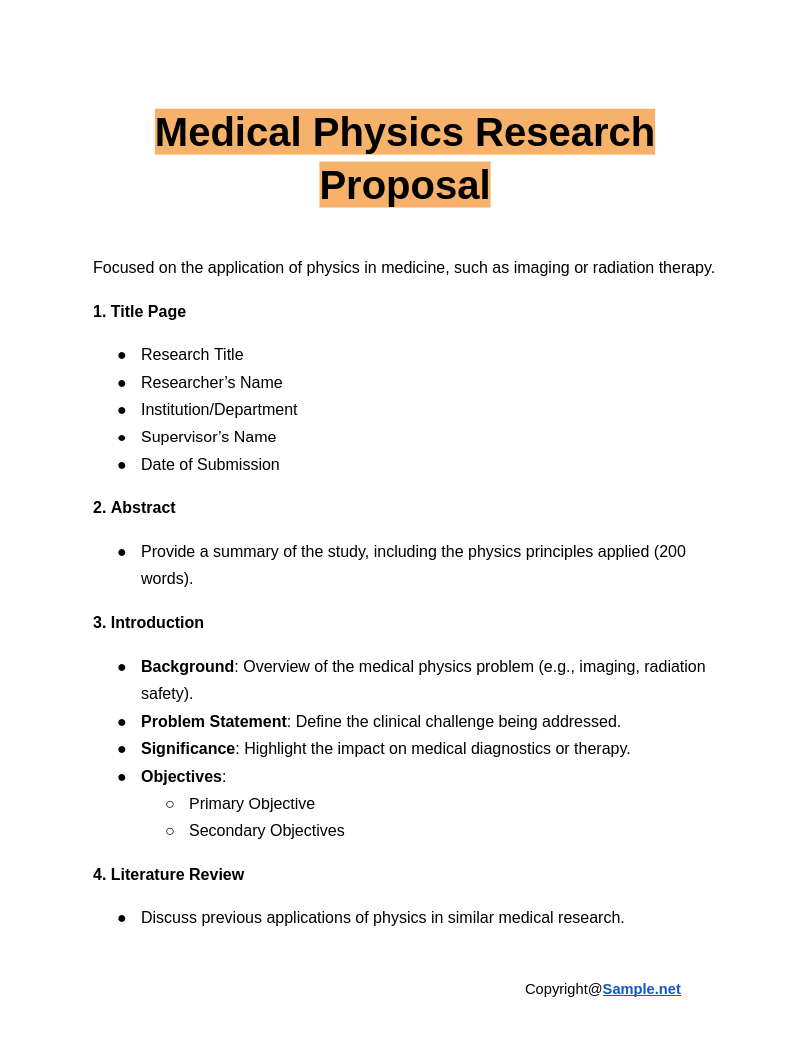
Medical Physics Research Proposal
download now -
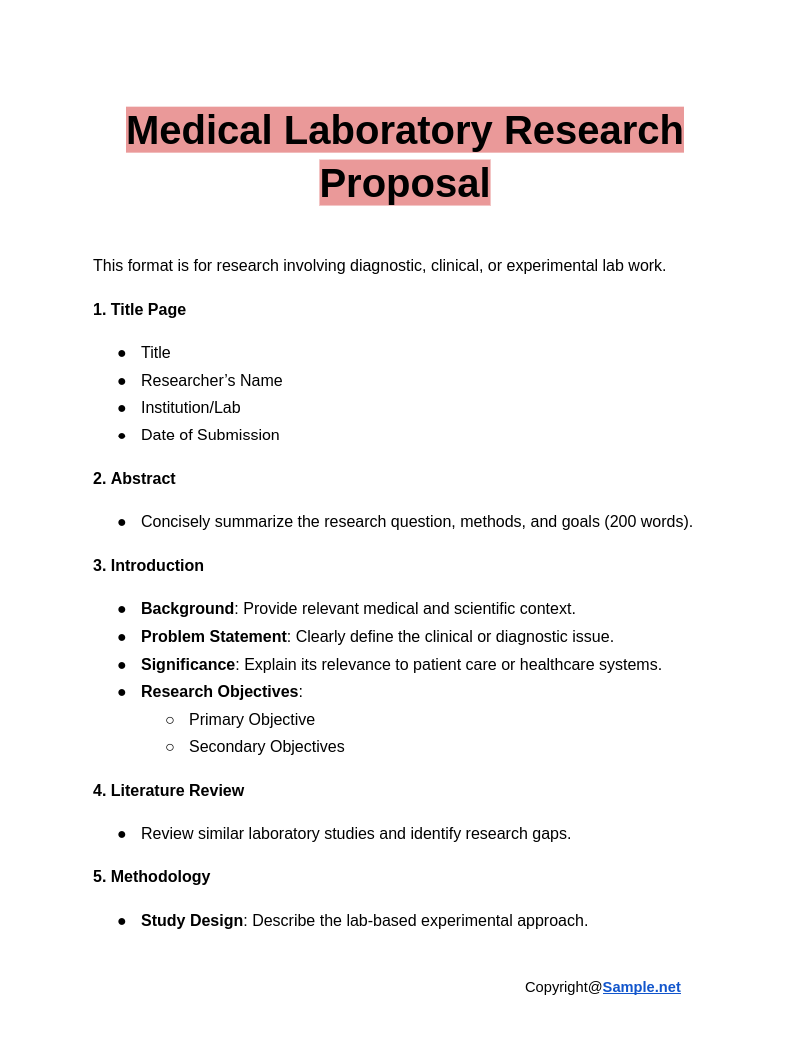
Medical Laboratory Research Proposal
download now -
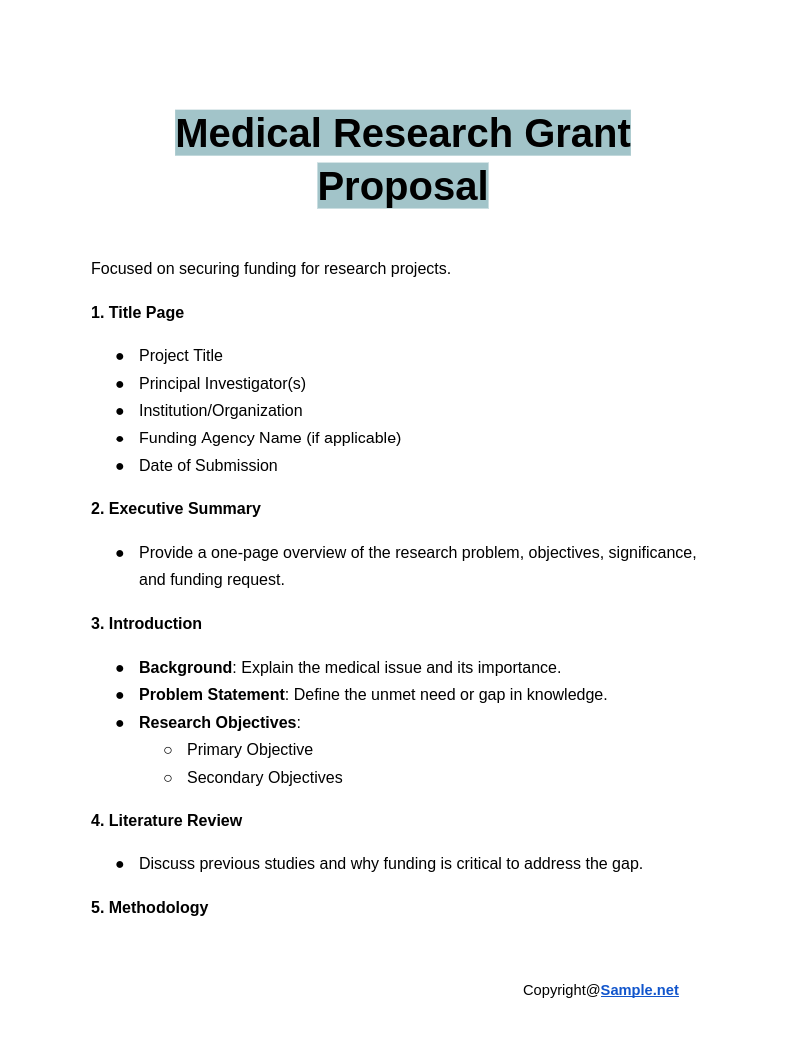
Medical Research Grant Proposal
download now -
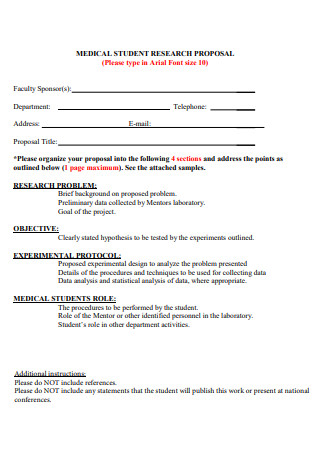
Medical Student Research Proposal
download now -
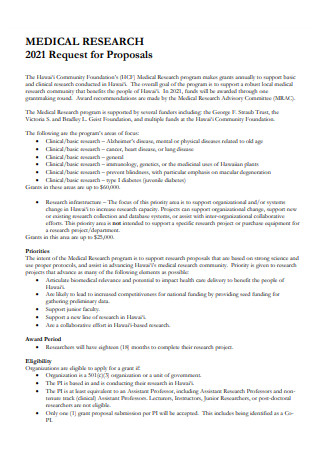
Medical Research Request For Proposal
download now -
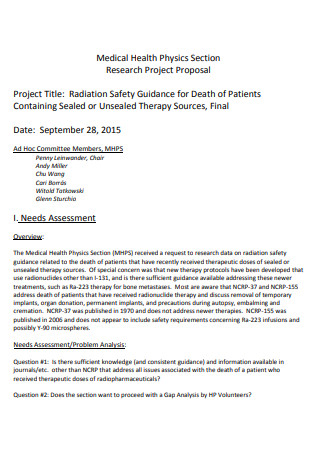
Medical Health Research Project Proposal
download now -
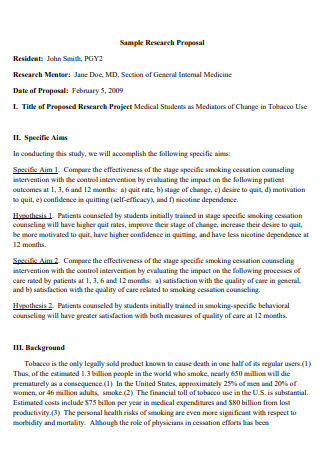
Sample Medical Research Proposal
download now -
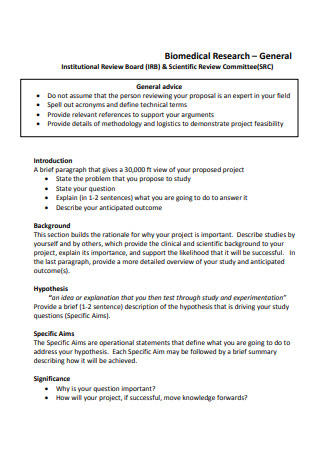
Bio-Medical Research Proposal
download now -
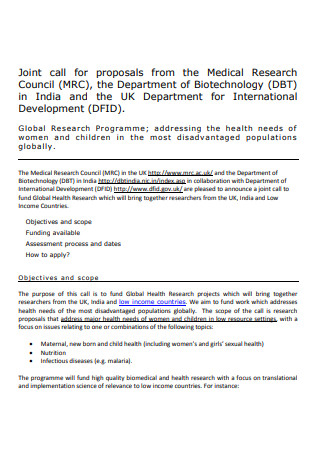
Medical Research Council Proposal
download now -
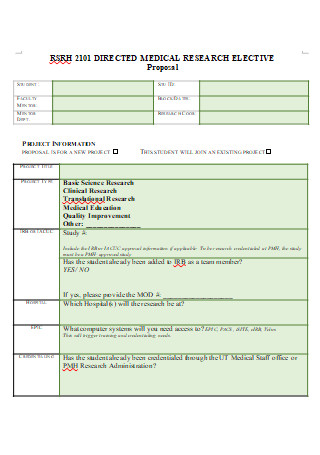
Medical Research Proposal in DOC
download now
FREE Medical Research Proposal s to Download
Medical Research Proposal Format
Medical Research Proposal Samples
What is a Medical Research Proposal?
What Should the Medical Research Proposal Contain?
How to Structure your Medical Research Proposal
FAQs
Why is funding important for medical research?
What distinguishes a good research proposal from a bad one?
Why are you required to submit a research proposal?
What is the purpose of your research proposal, and why is it crucial?
How long should my research proposal be?
What are common challenges in creating a Medical Research Proposal?
What is the role of collaboration in a Medical Research Proposal?
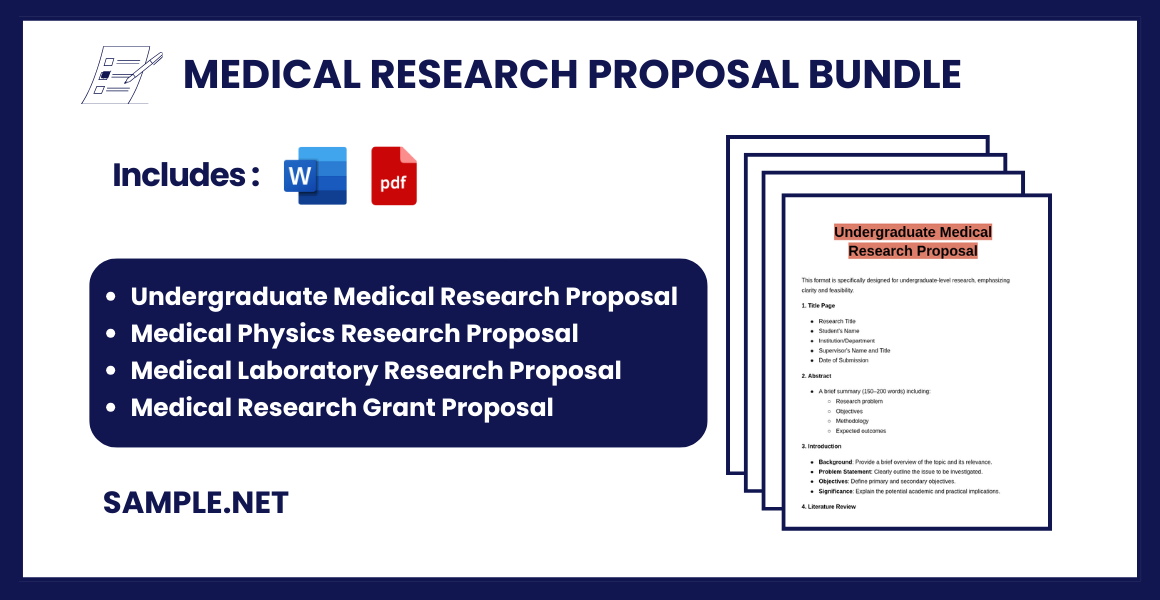
Download Medical Research Proposal Bundle
Medical Research Proposal Format
1. Title Page
- Title of the research project
- Name(s) of the principal investigator(s)
- Institution/Organization affiliation
- Date of submission
- Contact details (email, phone number, and address)
2. Abstract
- A brief summary (150–250 words) of the research proposal.
- Include the research problem, objectives, methodology, and expected outcomes.
3. Introduction
- Background Information: Describe the context of the research, including a brief overview of the existing literature.
- Problem Statement: Clearly define the issue your research will address.
- Rationale/Significance: Explain why the research is important in the medical field and its potential contribution to science or healthcare.
- Objectives:
- Primary Objective: The main goal of the research.
- Secondary Objectives: Any additional objectives that support the primary goal.
4. Literature Review
- Summarize previous studies relevant to your research topic.
- Identify research gaps that your proposal seeks to address.
- Highlight the importance of your research in closing these gaps.
5. Methodology
- Study Design: Specify whether it is experimental, observational, cross-sectional, longitudinal, etc.
- Study Population:
- Inclusion criteria
- Exclusion criteria
- Sample Size: Justify the number of participants or data points.
- Data Collection Methods: Describe how data will be collected (e.g., interviews, surveys, clinical tests, etc.).
- Intervention (if applicable): Provide details on any interventions or treatments.
- Outcome Measures: Define how success or progress will be measured.
- Data Analysis: Outline the statistical methods or software you will use to analyze the data.
- Ethical Considerations:
- Ethical approval process
- Consent process
- Confidentiality and data protection measures
6. Hypothesis
- State the hypothesis your research will test (if applicable).
7. Expected Results
- Describe the potential outcomes and their relevance to medical practice or policy.
8. Timeline
- Provide a detailed timeline for the project, including key milestones like data collection, analysis, and report writing.
9. Budget
- Itemize costs for personnel, equipment, materials, travel, software, etc.
- Provide justification for the requested budget.
10. References
- List all the references cited in your proposal using an appropriate citation style (e.g., APA, Vancouver, or another required format).
11. Appendices (if necessary)
- Include any supporting documents such as:
- Questionnaires or surveys
- Figures or diagrams
- Letters of support or collaboration agreements
What is a Medical Research Proposal?
A Medical Research Proposal is a structured document that defines the scope, objectives, and methods of a medical study. It provides a detailed plan for conducting research to answer critical questions or test hypotheses in the medical field. This proposal helps in securing grants or institutional approvals, enabling researchers to address health challenges effectively. By setting clear goals and methodologies, it ensures that the research contributes meaningfully to medical science and patient care. You can also see more on Medical Proposal.
What Should the Medical Research Proposal Contain?
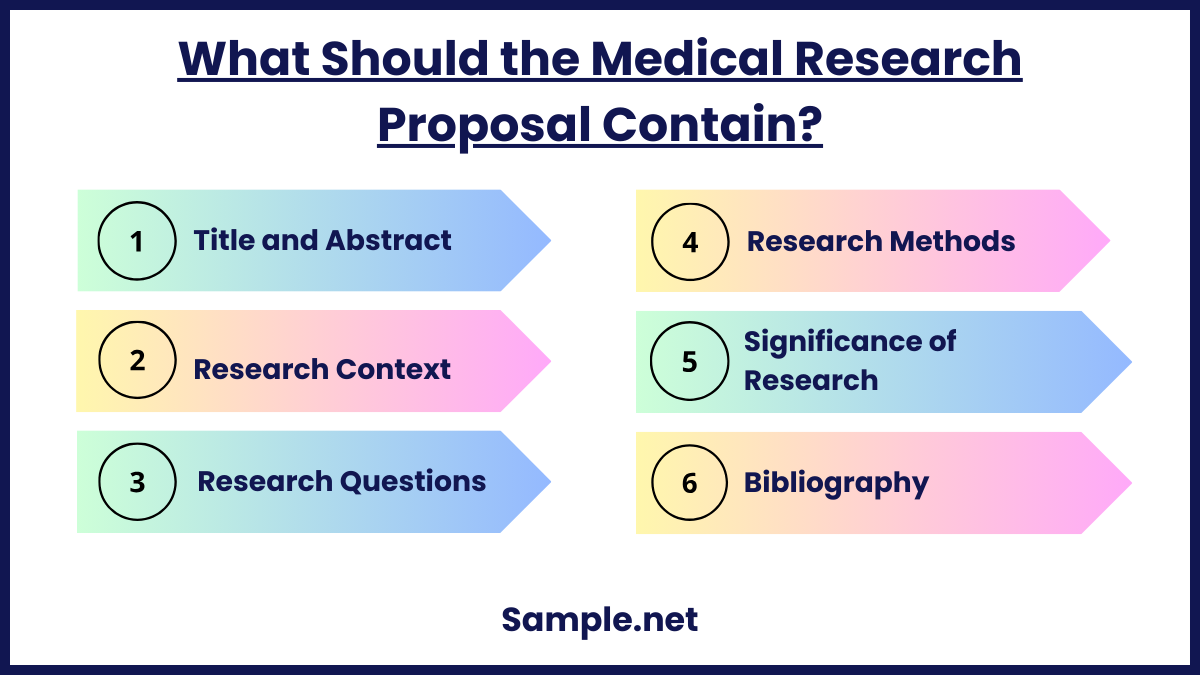
Whether you browse through the entire web, the answer to the question remains similar. It is the University of Birmingham that was able to summarize well that we will share with you what compromises a medical research proposal. Following this medical research proposal outline will help you in knowing what is usually included and what it is.
How to Structure your Medical Research Proposal
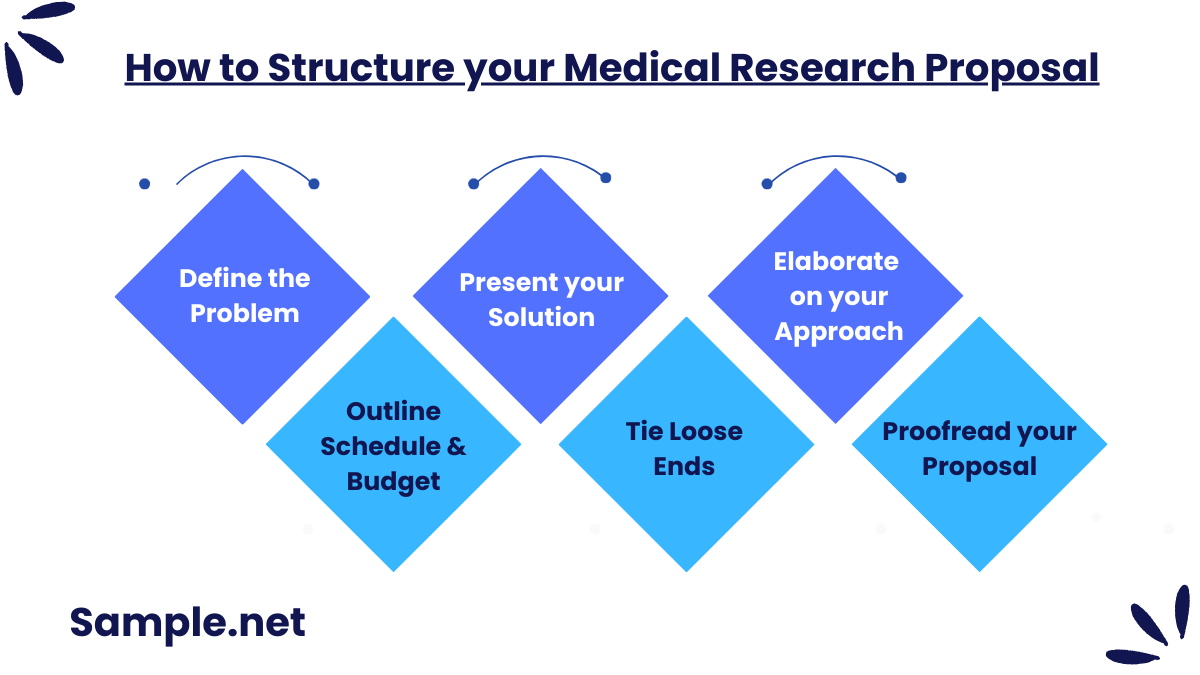
A medical research proposal sounds intimidating to most who wouldn’t know where to start or what to do. This is why this article provides you a medical research proposal format to guide you. Additionally, we have curated steps so you can better know which information goes for which part. Keep in mind that the purpose of developing a proposal is to gain executive support and make potential funders turn to you. You want influential individuals to back your initiative. As much as possible, they should be moved by the proposal which would lead to the next step, which is to approve the medical research proposal. View our example medical research proposal that has been provided in this article. You can also see more on Postgraduate Research Proposal.
Step 1: Define the Problem
You have to make your audience understand why you find your topic to be a medical problem that should be addressed sooner than later. This is the part where you need to be able to get people hooked otherwise they may not be so interested to completely read the rest of the medical research proposal. Make sure that the points you are stating resonate with your audience and panelists. But don’t forget to stay factual and avoid personal or subjective opinions.
This is why Research Statements summarizes the contents in order to identify the goals, findings, and future plans regarding a medical-related research topic.
Step 2: Present your Solution
Naturally, what comes after a problem would be its solution. This part is where you discuss how your proposal comes into the picture to offer a solution to the problem. You may state similar studies that were close to effective so you can reinforce your point that your proposal may be that exact solution that the medical field can prosper with. This part may be crucial because questions and objections may be thrown at you to test your knowledge in defending your research topic. You can focus on a long-term solution even if it would take a significantly longer amount of time to study.
Step 3: Elaborate on your Approach
This is the most important portion of the proposal because it explains how to meet the proposal’s goals. It begins with a description of the strategy and why it is useful and effective. It also describes how issues will be dealt with. This step is where you are able to elaborate further on the points you may have not made in earlier steps. Or even how you came to decide which method fits best to the study you are proposing to conduct. You can also see more on Health Project Proposal.
Step 4: Outline your Schedule and Budget Plan
Medical bills are known to be expensive so relating it to a Research Budget, you would expect research to have a certain amount tied to them for it to be conducted. Give as much information as you can. Divide your budget into areas like medical equipment, access to limited information, travel or transportation, and so on. Include all indirect and overhead spending. A thorough financial analysis shows audiences that you’ve done your homework and won’t waste their money. It helps to be as concrete as possible, you can even provide the estimated time of day when you will begin your study and how long it could take for a result to be conclusive.
Step 5: Tie Loose Ends
Finish your proposal with a few lines that summarize the problem, solution, and benefits. Restate essential concepts or data you want your audience to remember in your proposal to make it stand out. Examine your proposal for consistency of thought and to see if the components work together. Make sure there are no loose ends nor did you introduce a topic that was left unanswered. A striking introduction is just as necessary as a distinct closing statement.
Step 6: Proofread your Proposal
This step should not be forgotten simply because you have finished your proposal. You can’t be lax in letting errors be spotted or forgetting to check your grammar and typos. Since you are dealing with medical information, it is important to be on top of faults. You can take a night’s rest before going back to review your medical research proposal and then you should send it for presentation or defense. Never submit it right away.
FAQs
Why is funding important for medical research?
Hospital Budgets are not to be taken lightly. The equipment, medicine, and billing, in general, can become quite expensive. It wouldn’t come as a surprise that medical research needs to have an adequate amount of funding so it can go forward. This is why a medical research proposal is necessary to persuade prospective funders to support your research.
What distinguishes a good research proposal from a bad one?
A successful proposal defines and evaluates the techniques you will use to conduct your study, as well as clearly describes your research topic. An effective research proposal must also place your research in the context of a wider field of study and explain why it is important. You can also see more on Scientific Research Proposal.
Why are you required to submit a research proposal?
Writing a medical research proposal can help you to explain your goals and key arguments. It will allow you to consider each stage of the research process in order to create a clear and thorough strategy. As stated, you should not proceed with submitting your document before verifying all that you have written are factual and is connected to the general topic you have chosen.
What is the purpose of your research proposal, and why is it crucial?
According to the University of Westminster, it is used to determine whether there is expertise to support your suggested topic of study, and as your ideas grow, your proposed research will most likely develop further. Not only that, but it could also add or change existing knowledge and improve the lives that have been affected. You can also see more on Laboratory Proposal.
How long should my research proposal be?
A medical research proposal could have 2,000 to 3,500 words and the document may be four to seven pages long. But keep in mind that different funding bodies might require a specific amount or have a different word limit.
What are common challenges in creating a Medical Research Proposal?
Challenges include identifying a unique research problem, designing an ethical and feasible methodology, and preparing a convincing budget. Researchers may also face difficulties in adhering to specific guidelines required by funding bodies. Time constraints and limited resources can further complicate the process. Overcoming these requires meticulous planning, collaboration, and persistence. You can also see more on Health Care Proposals.
What is the role of collaboration in a Medical Research Proposal?
Collaboration strengthens proposals by combining expertise, resources, and diverse perspectives. Partnering with institutions, researchers, or organizations enhances credibility and broadens the scope of the study. Collaborative efforts often attract more funding and lead to impactful results.
